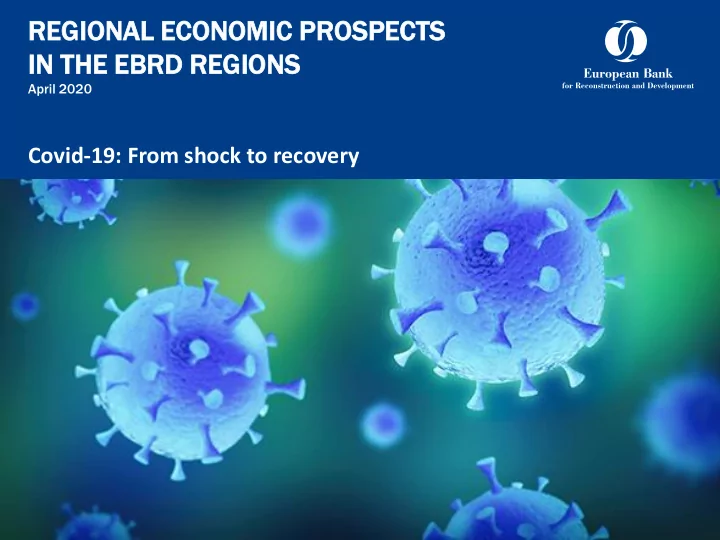

REGIONAL IONAL ECONOMI NOMIC C PROSPECT SPECTS IN T N THE HE EBRD RD REGIONS IONS April 2020 Covid-19: From shock to recovery
Economic impact of domestic containment measures is compounded by external shocks Containment measures aimed at slowing down the spread of the virus affect domestic demand (due to restrictions on consumptions, people spending less) and domestic supply (as fewer people can work) Channels through which the Covid-19 crisis could affect the EBRD regions Source: Authors 2
Effects of domestic containment measures will be greater where services account for a larger share of GDP Wholesale and retail trade, transport, accommodation and food service activities as a share of GDP, 2018 (per cent) Sources: Eurostat, OECD and authors’ calculations. 3
Impact may be greater where informality is higher and permanent contracts less prevalent Most people do not have permanent contracts in Central Asia, Eastern and South-eastern Europe Share of those employed in the last year by contract type, 2016 (per cent) 100 Permanent written contract Fixed-term written contract 90 80 70 60 50 40 30 20 10 0 Azerbaijan Tajikistan Turkey Cyprus Greece Ukraine Armenia Albania Georgia Kyrgyz Republic Kazakhstan Kosovo Russia Moldova Uzbekistan Mongolia Montenegro North Macedonia Bosnia and Herz. Serbia Croatia Belarus Hungary Poland Romania Bulgaria Estonia Latvia Slovenia Slovak Republic Lithuania Czech Republic Germany Italy Sources: Life in Transition Survey (2016) and authors’ calculations. 4
Effects may be greater where self-employment is more widespread Share of self-employment is particularly high in the Caucasus and Central Asia Share of self-employment and small firm employment, 2016 (per cent) 80 LITS self-employed LITS small firms WDI 70 60 50 40 30 20 10 0 Belarus Russia Estonia Hungary Bulgaria Lithuania Latvia Croatia Slovenia Cyprus Slovak Rep. Ukraine Poland Montenegro Bosnia and Herz. North Macedonia Romania Kazakhstan Serbia Turkey Greece Moldova Kyrgyz Rep. Armenia Uzbekistan Tajikistan Mongolia Georgia Albania Azerbaijan Germany Italy Sources: Life in Transition Survey (2016), World Development Indicators and authors’ calculations . Self-employed (ILO definition) 5 include members of producers' cooperatives and contributing family worker. Small firms employ fewer than 5 people.
Sources: IMF and authors’ calculations. 100 120 20 40 60 80 face greater risks Firms with already high levels of debt 0 Cyprus Turkey Greece Russia Bulgaria Georgia Corporate domestic debt as a share of GDP, 2019 (per cent) Estonia Belarus Armenia Serbia Bosnia and Herz. Croatia Slovak Republic Slovenia Ukraine Mongolia Hungary Albania Lithuania Kyrgyz Republic Latvia Poland Moldova Romania North Macedonia 6 Kazakhstan
Fiscal space available to countries to finance crisis response measures varies The cost of borrowing in financial markets is already high in some countries such as Russia, Turkey and Ukraine General government net lending/borrowing General government gross debt as a share of GDP and bond yields as a share of GDP, 2018 (per cent) 18 [CELLRANGE Government bond yield, EUR/USD, LBN 16 ] debt: 14 12 latest (per cent) [CELLRANGE [CELLRANGE ] [CELLRANGE [CELLRANGE 10 ] ] [CELLRANGE ] 8 [CELLRANGE [CELLRANGE ] [CELLRANGE [CELLRANGE 6 ] [CELLRANGE ] [CELLRANGE ] ] [CELLRANGE [CELLRANGE ] [CELLRANGE 4 [CELLRANGE [CELLRANGE ] [CELLRANGE [CELLRANGE ] [CELLRANGE ] [CELLRANGE ] ] [CELLRANGE [CELLRANGE ] 2 ] ] [CELLRANGE ] GRC [CELLRANGE ] [CELLRANGE [CELLRANGE [CELLRANGE ] [CELLRANGE ] [CELLRANGE [CELLRANGE ] [CELLRANGE debt: 0 ] ] ] ] ] ] 177 ] ] -2 -30 20 70 120 Gross government debt as a share of GDP, 2019 (per cent) Sources: IMF estimates. 7
Policy response also focused on lower interest rates, liquidity support, guidelines on forbearance The crisis may compound the already high levels of non-performing loans in a number of countries If protracted lockdowns, concerns about maintaining culture of paying bills on time – key market institution Non-performing loans as a share of total loans, 2018 (per cent) Sources: CEIC, national authorities and authors’ calculations. 8
Oil price drop to levels last seen in 1999 (in inflation-adjusted terms) on weak outlook As Russia refused to agree production cuts with OPEC and Saudi Arabia increased production Nominal and real oil price ( US$ per barrel of Brent) Sources: Bloomberg, IMF and authors’ calculations. 9
Disruptions to trade and global value chains will hurt highly integrated countries in the EBRD regions Many car plants around the world, including in Serbia, had to halt production due to missing parts early Global value chain participation as a share of exports, 2018 (per cent) Sources: EBRD SEMED Global Value Chain Diagnostics and UNCTAD-EORA (2019). 10
Several economies in the EBRD regions are highly vulnerable to collapse in global tourism Tourism revenues exceed 20% of GDP in Georgia, Albania, Croatia, Montenegro, Cyprus and Greece Travel and tourism as a share of GDP, 2018 (per cent) Sources: World Bank, World Travel and Tourism Council and authors’ calculations. 11
Some countries in the EBRD regions are highly dependent on remittances Remittances are concentrated in terms of source countries (Russia, the Gulf Cooperation Council, France, Germany and Italy), making recipient countries vulnerable to large shocks hitting the sending economies Remittances received as a share of GDP (per cent) Remittances from the largest sender country Remittances from all other countries 35 30 25 20 15 10 5 0 Bosnia and… Turkmenistan Turkey Greece Kazakhstan Russian Federation Slovenia Poland Cyprus Romania Estonia Slovak Republic Belarus North Macedonia Lithuania Azerbaijan Hungary Bulgaria Latvia Croatia Mongolia Tunisia Morocco Uzbekistan Serbia Egypt, Arab Rep. Albania Montenegro Jordan Ukraine Armenia Georgia Lebanon Kosovo Moldova West Bank and Gaza Kyrgyz Republic Tajikistan Sources: Central Bank of Russia, national authorities, World Bank and authors’ calculations. From Russia to Armenia, Azerbaij an, Belarus, Georgia, 12 Kazakhstan, Kyrgyz R. , Moldova, Mongolia, Tajikistan, Turkmenistan, Ukraine, Uzbekistan; inflation-adjusted moving average, 2013Q4=100.
Recommend
More recommend